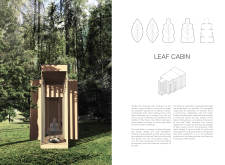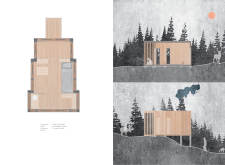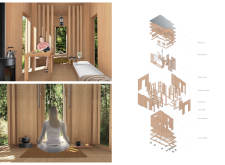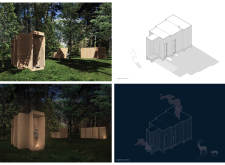5 key facts about this project
The architecture of the Leaf Cabin is inspired by the organic shapes of nature, specifically drawing from the form of a tea leaf. This conceptual inspiration not only informs the silhouette of the cabin but also translates into a design ethos that emphasizes harmony with nature. The elongated, curved structure gently nestles into the landscape, offering both aesthetic appeal and functional benefit. The design encapsulates the essence of tranquility, encouraging occupants to immerse themselves in the surrounding environment as they engage with their thoughts, meditate, or participate in leisurely activities like tea brewing.
Functionally, the Leaf Cabin is divided into distinct areas each catering to various needs and activities. It features a welcoming entrance that guides visitors into the space, providing a sense of transition from the outside world to the calm interior. The main living area is designed to maximize natural light, with expansive glass panels that offer unobstructed views of the forest, blurring the lines between indoor and outdoor spaces. This thoughtful arrangement facilitates an enhanced appreciation for the landscape, allowing occupants to feel deeply connected to their surroundings.
A dedicated meditation space within the cabin embodies the project's focus on mindfulness. This serene area is oriented towards views of the natural landscape, promoting reflection and peace. Additionally, there is a tea preparation area, which serves as both a functional space and a thematic nod to the moments of connection and pause that tea symbolizes. The cabin also comprises a cozy sleeping area that provides a restful retreat, allowing for rejuvenation amidst a tranquil setting.
The unique design approaches employed in the Leaf Cabin highlight the importance of sustainability and local material use. The primary material, local spruce wood, is carefully selected not only for its durability but also for its warm aesthetic that complements the surrounding environment. Incorporating large glass elements in the design further amplifies the connection with nature, permitting daylight to enter and creating an inviting atmosphere. The inclusion of a metal cap on the roof not only ensures protection from the elements but also adds a modern touch to the overall architectural expression.
Attention to detail is evident in every aspect of the Leaf Cabin's design. The interplay of materials, the thoughtful layout, and the consideration of the natural landscape come together to create an immersive experience. The cabin stands as a representation of a mindful approach to architecture—one that values ecological sensitivity while promoting personal well-being.
Visitors interested in delving deeper into the architectural aspects of the Leaf Cabin are encouraged to explore its architectural plans, sections, and design concepts. Engaging with these details will provide further insights into the innovative ideas and meticulous planning that define this architectural project. The Leaf Cabin exemplifies a harmonious balance between built and natural environments, serving as a testament to the potential of architecture to enrich our lives in a modest yet profound manner.


























